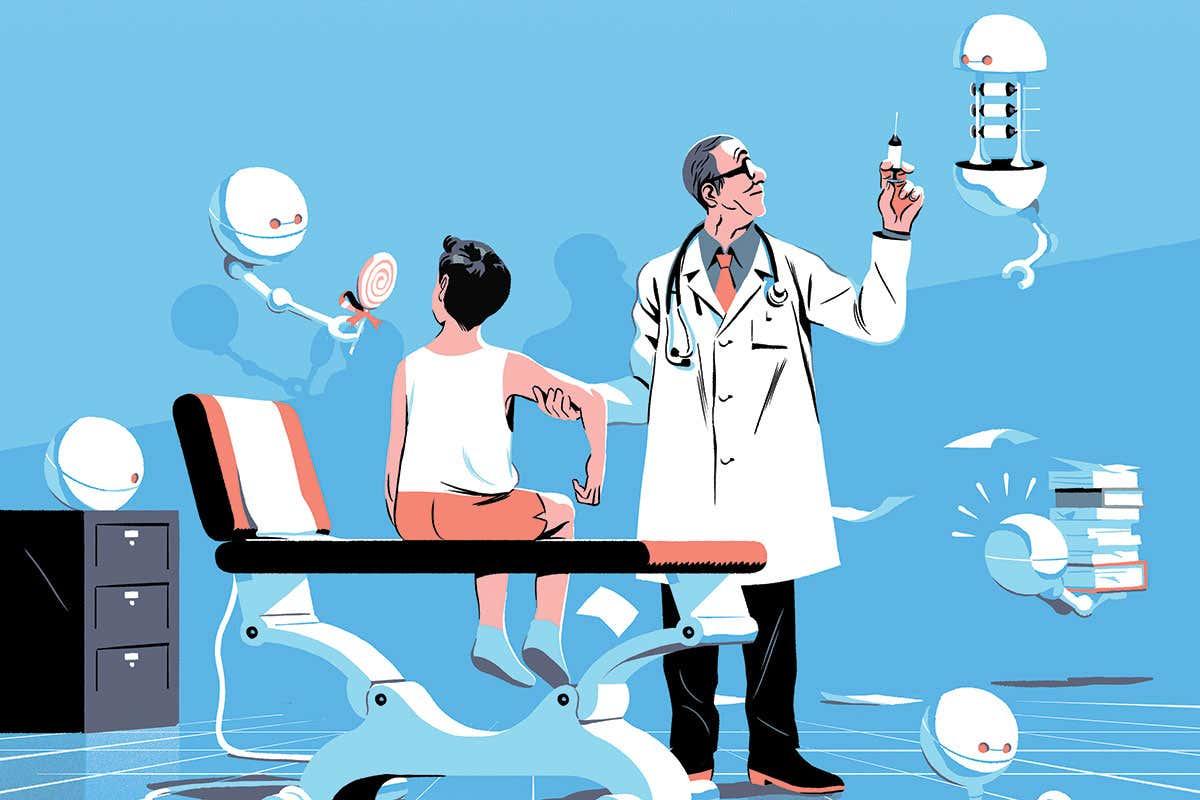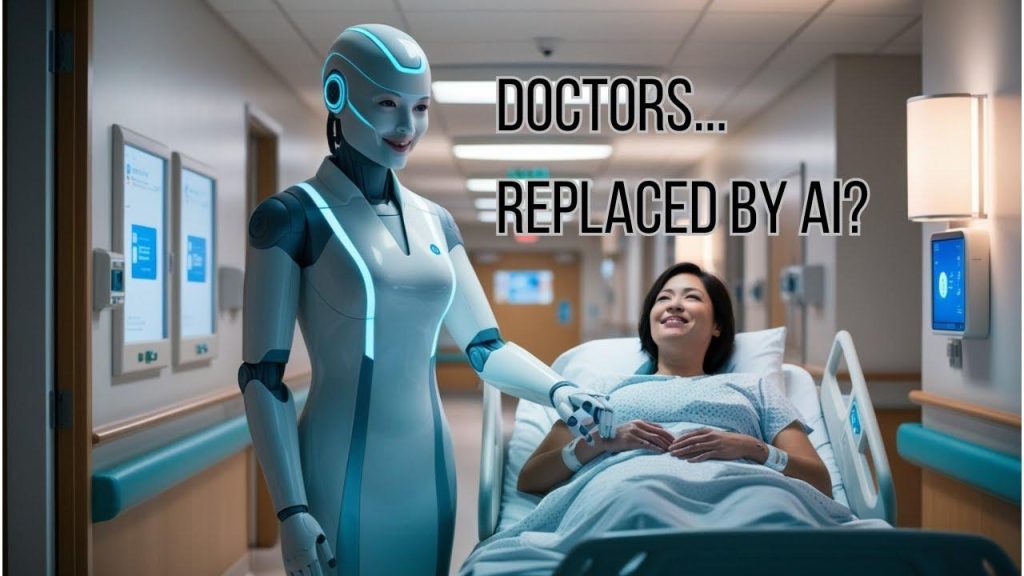In a world where technology constantly reshapes our lives, the realm of healthcare is experiencing a dramatic change through the integration of artificial intelligence (AI). A recent study from Stanford University has illuminated the remarkable capabilities of AI, revealing that it can diagnose complex medical cases with an notable 92% accuracy, overshadowing the 74% accuracy of human doctors. This breakthrough prompts a provocative question: Could AI truly be on the path to replacing doctors,or is this merely a sign of a broader revolution within the healthcare landscape? With the AI healthcare market skyrocketing from $1.1 billion in 2016 to an remarkable $22.4 billion in 2023, and projections suggesting it could reach nearly $208 billion by 2030, the evolution of AI in medicine is not just a glimpse of the future—it’s a present reality. As hospitals increasingly embrace AI for diagnostics and patient monitoring, the dialog around its role becomes ever more critical. Experts suggest that rather than rendering doctors obsolete, AI may serve as a powerful ally, enhancing the efficiency and effectiveness of medical care by allowing healthcare professionals to focus more on the human elements of their profession. Though,as promising as these advancements are,questions surrounding trust,empathy,and the potential for errors linger; the future of healthcare may depend not on the replacement of doctors,but on a harmonious collaboration between human expertise and cutting-edge technology.
The Promise of AI in Healthcare: Transforming Diagnostics and Patient Care
The integration of AI in healthcare is enhancing diagnostics by offering unparalleled data analysis capabilities. By leveraging vast datasets, AI systems can uncover patterns and correlations that may escape even the most experienced human practitioners.These technologies not only analyze medical images with high precision but also continuously learn from new cases, thereby improving their diagnostic algorithms. This analytical prowess enables a range of applications, such as:
- Early disease detection: AI can identify anomalies in imaging studies before symptoms manifest.
- Personalized treatment plans: Algorithms can suggest tailored therapies based on individual patient data.
- Predictive analytics: Models can forecast disease progression and potential complications, enabling proactive care.
Moreover,the patient experience is also being redefined through AI-enabled tools that promote engagement and streamline dialogue. Virtual health assistants and chatbots are becoming commonplace, providing patients with immediate access to information and support. By facilitating appointment scheduling, medication reminders, and health literacy resources, these tools ensure patients remain informed and active participants in their care. This shift may foster a more collaborative atmosphere, where healthcare providers can dedicate their time to building meaningful relationships. As AI applications continue to proliferate, the synergy between technology and human touch will likely be paramount in achieving optimal patient outcomes.
Balancing Innovation with Empathy: The Human Element in Medical Practice
As healthcare continues to evolve, the importance of human connection in medical practice cannot be overstated. While AI brings remarkable efficiencies and analytical skills, patient care often necessitates an understanding of emotional and psychological nuances that algorithms cannot replicate. For instance, a patient’s journey can be fraught with anxiety, fear, or uncertainty, which requires healthcare providers to offer not just treatment but also genuine empathy and reassurance. Practitioners with robust interpersonal skills can create environments where patients feel heard and valued, ultimately enhancing adherence to treatment plans and improving health outcomes.
- Cultural competency: Human practitioners can navigate the complexities of diverse backgrounds, tailoring care to fit unique cultural needs.
- Emotional support: Physicians can provide comfort during tough diagnoses, fostering a therapeutic alliance that standard algorithms cannot provide.
- Adaptive communication: Clinicians can modify their communication styles based on patient cues, ensuring messages are received and understood.
Furthermore, the collaborative potential between AI and human practitioners should be further emphasized. AI tools can handle data-intensive tasks, freeing up valuable time for healthcare professionals to engage patients on a more personal level. This collaborative approach not only aids in triaging cases swiftly but also allows physicians to devote their expertise to nuanced discussions around treatment options and care trajectories—elements that AI alone cannot administer. The future of healthcare lies in a model that leverages both cutting-edge technology and compassionate human interaction, ensuring that the treatment of medical conditions is just as important as addressing the individual behind the illness.
Challenges and Limitations of AI: Ensuring Accuracy and Trust in Healthcare
Despite the increasing presence of AI in healthcare, notable challenges must be addressed to foster trust among patients and practitioners. One major concern is the accuracy of AI-driven diagnostics. While AI can analyze data at an exceptional speed, inaccuracies in algorithms or biases in the initial data training can lead to erroneous conclusions. These mistakes can perhaps jeopardize patient safety, making it crucial to implement rigorous validation standards. Additionally, issues such as data privacy and the ethical implications of relying on automated systems raise critical questions about accountability.Stakeholders must develop comprehensive oversight mechanisms to monitor AI tools, ensuring they adhere to established medical guidelines.
- Data quality: The source and integrity of data used to train AI systems play a pivotal role in their effectiveness.
- Clarity: Clear communication regarding how AI solutions reach conclusions is essential for maintaining trust.
- Regulatory frameworks: Developing and enforcing laws that safely govern AI request in healthcare is vital.
Moreover, the interpersonal dynamics within medical settings cannot be overlooked. AI lacks the ability to convey empathy and understanding, basic aspects of the doctor-patient relationship. The fear of being treated by a machine can lead to resistance from both patients and healthcare providers alike. Therefore, educational initiatives focusing on AI’s complementary role in healthcare are essential. By empowering practitioners with knowledge about AI’s capabilities and limitations, the healthcare community can build a framework where technology supports clinical judgment rather than replaces it, ensuring a balanced approach to patient care.
- Patient education: Informing patients about AI capabilities can alleviate fears and increase acceptance.
- Interdisciplinary collaboration: Encouraging teamwork between technologists and healthcare providers will enhance trust in AI applications.
- Continuous training: Regular updates and training for practitioners will bridge the gap between human care and AI technology.
The Future of Medicine: Collaborating with AI to Enhance Doctor-Patient Relationships
The integration of artificial intelligence into the healthcare sector opens new avenues for enhancing the doctor-patient dynamic. By automating routine tasks, such as data collection and administrative documentation, AI can enable practitioners to dedicate more time to direct patient engagement, which is essential for fostering trust and communication. As AI tools provide real-time information about patient conditions, doctors can utilize this data to have informed discussions, answering patient queries with greater precision. This increased interaction can promote a sense of partnership, as patients feel more involved in their healthcare journey and knowledgeable about their treatment options.
- Enhanced data accessibility: With AI systems streamlining data analysis, doctors can offer personalized insights that resonate with patients.
- Improved follow-up care: AI can assist in tracking patient progress, allowing practitioners to proactively address concerns and refine treatment strategies.
- Empathetic dialogue: AI can equip doctors with tools to better understand patient histories, facilitating more meaningful conversations.
Furthermore, the future may see AI functioning as a supportive entity that enriches the emotional aspect of healthcare. While algorithms can provide diagnostic insights, they lack the ability to demonstrate compassion, a critical aspect of medical care that human practitioners excel at. By incorporating AI’s analytical strengths, doctors can enhance their delivery of empathetic care. The blend of technology and compassionate communication could lead to a healthcare environment where patients feel valued not just as data points, but as individuals whose stories and emotions are recognized and responded to. This complementary relationship between AI and human practitioners may ultimately reshape how care is administered, prioritizing patient experience alongside clinical accuracy.
- Patient-centered approaches: Leveraging AI tools to adapt care strategies to individual preferences enhances patient satisfaction.
- Collaborative insights: AI can inform treatment discussions, allowing for a more rounded viewpoint of patient needs.
- Trust-building interactions: Improved communication facilitated by AI insights can reinforce the patient-doctor relationship.























